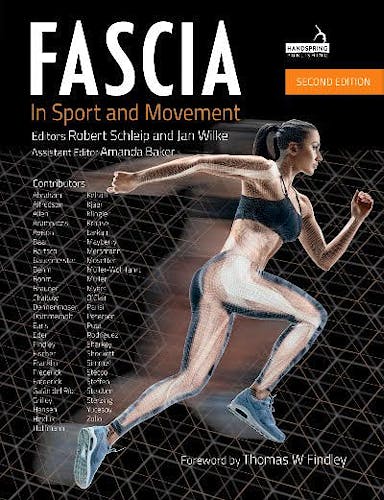

No hay productos en el carrito



Fascia in Sport and Movement
Schleip, R. — Wilke, J.
2ª Edición Abril 2021
Inglés
Tapa blanda
636 pags
890 gr
19 x 25 x 3 cm
ISBN 9781912085774
Editorial Handspring
LIBRO IMPRESO
-5%
94,56 €89,83 €IVA incluido
90,92 €86,38 €IVA no incluido
Recíbelo en un plazo de
7 - 10 días
Section 1 Theory
- Highlights of fascial anatomy, morphology and function
- Surprising facts about fascial physiology and biochemistry
- Sex hormonal effects on tendons and ligaments
- Stress loading and matrix remodeling in tendon and skeletal muscle: Cellular mechano-stimulation and tissue remodeling
- Mechanical loading and adaptive responses of tendinous tissues
- Nutrition and loading to improve fascia function
- Hypo- and hypermobility
- Elastic storage and recoil dynamics
- Water and fluid dynamics in fascia
- What is it good for? An evidence-based review of stretching in sport and movement
- Biotensegrity in sport and movement
- Myofascial continuity: Towards a new understanding of human anatomy
- Mechanical force transmission across myofascial chains
- Myofascial force transmission to synergistic and antagonistic muscles
- Fascia as sensory organ
- Fascia and musculoskeletal injury: An underestimated association?
- Classification of athletic injuries to muscular tissues
- Fascia, exercise and oncology
Section 2 Assessment methods
- Assessment of joint mobility
- Imaging techniques (ultrasound)
- Mechanical assessment
- Palpation and functional assessment methods for fascia-related dysfunction
Section 3 Clinical application
- Integrating clinical experience and scientific evidence – Roadmap for a healthy dialog between health practitioners and academic researchers
- Fascial Fitness
- Basic principles of plyometric training
- Eccentric training: The key for a stronger, more resilient athlete?
- Foam rolling and roller massage effects and mechanisms
- Fascial stretching
- Food for the fascia: Molecular and biochemical processes
- Walking: The benefit of being on two legs
- Functional training methods for the runner’s myofascial systems
- Shoes or no shoes during locomotion and exercise – Training potential for fascial structures of the lower extremity
- Overarm throwing in humans
- The secret role of fascia in the martial arts
- The world as a playground: Ninja and parkour training
- Anatomy Trains in motion
- Fascial form in yoga
- Yin yoga as a fascia-oriented practice
- Fascia-focused Pilates training
- Three-dimensional fascia-oriented training
- Dance
- Kettlebell training
- Fascia-oriented strength training in a conventional gym environment
- Rehabilitation in sport medicine
- How to train fascia in soccer
- Movement therapy for breast cancer survivors
- Mental imagery, fascia and movement
- Periodized fascia training for speed, power, and injury resilience
Fascia in Sport and Movement, Second edition is a multi-author book with contributions from 51 leading teachers and practitioners across the entire spectrum of bodywork and movement professions. It provides professionals from all bodywork and movement specialisms with the most up-to-date information they need for success in teaching, training, coaching, strengthening, tackling injury, reducing pain, and improving mobility.
The new edition has 21 new chapters, and chapters from the first edition have been updated with new research.
This book is an essential resource for all bodywork professionals – sports coaches, fitness trainers, yoga teachers, Pilates instructors, dance teachers and manual therapists. It explains and demonstrates how an understanding of the structure and function of fascia can inform and improve your clinical practice.
The book’s unique strength lies in the breadth of its coverage, the expertise of its authorship and the currency of its research and practice base.
Fascia in Sport and Movement, Second edition:
- Enhances the knowledge of the sports professional, yoga teacher and Pilates instructor, enabling them to better understand and manage soft tissue injuries
- Offers the movement and manual therapist information on how different activities influence the body’s soft tissue matrix, and the types of injuries which may occur
- Is compiled and edited by Dr Robert Schleip and Dr Jan Wilke, two of the foremost researchers in the field of fascia for sport and movement
- Assembles a team of experts who provide a thorough and engaging distillation of the latest research and its practical applications
New content for the second edition!
- New chapters cover the influence of sex hormones on fascial connective tissues; plus the topics of nutrition, fluid dynamics, biotensegrity, hypo-and hypermobility, injury prevention and oncology.
- The section on clinical applications is now expanded by new chapters on eccentric training, foam rolling, walking, throwing, footwear, fascial strength training, mental imagery and more.
- Exciting new answers to clinical questions and problems and a multitude of reliable and novel information
New inspiring questions, careful hypothetical speculations, as well as valuable clinical observations - A completely new section (See Section 2) on assessment methods and including new chapter contributions on joint mobility examination, ultrasound imaging techniques and mechanical assessment
Reviews and Awards
‘Fascia in Sport and Movement is the best source to date on the practical applications of fascia science to athletics and movement disciplines. It is essential reading for coaches, athletes, trainers, movement teachers, manual therapists, as well as anyone else interested in how fascial understanding can improve performance, expression, and movement freedom.’ Til Luchau, Director of Advanced-Trainings.com and author of Advanced Myofascial Techniques
Robert Schleip MA PhD directs the Fascia Research Project at Ulm University, Germany and is Research Director of the European Rolfing Association. He is a certified Rolfing Instructor and Feldenkrais teacher. He is author and co-editor of several books and has written numerous research articles. For his laboratory research work on active contractile properties in fascial tissues he was awarded the Vladimir Janda Award for Musculoskeletal Medicine. He was the co-initiator and organizer of the inaugural Fascia Research Congress (Boston, 2007) as well as all subsequent congresses.
© 2025 Axón Librería S.L.
2.149.0